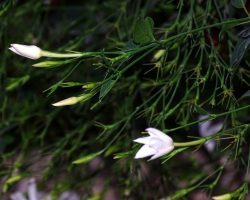Are you ready to add some vibrant color to your garden? Look no further than anemone tubers! These popular flowering plants are known for their beautiful blooms and are relatively easy to plant and care for. In this article, we will provide you with step-by-step instructions on how to plant and divide anemone tubers, ensuring a stunning display of flowers in your garden.
First, let’s talk about planting anemone tubers. Before you start, it’s important to choose the right location for these plants. Anemones thrive in areas with full sun or partial shade, so find a spot in your garden that receives adequate sunlight. The soil should be well-draining and rich in organic matter. If your soil is heavy and clay-like, consider adding compost or well-rotted manure to improve its texture.
To prepare the soil, start by loosening it with a garden fork or tiller. This will help the tubers establish their roots more easily. Next, add organic matter such as compost or peat moss to enrich the soil. This will provide the necessary nutrients for the tubers to grow and bloom. Additionally, check the pH level of your soil. Anemones prefer slightly acidic soil, so adjust the pH if necessary.
Now it’s time to plant the anemone tubers. Dig a hole that is about 2-3 inches deep and place the tuber in the hole with the pointed end facing up. Space the tubers about 4-6 inches apart to allow room for growth. Once the tubers are in place, cover them with soil and gently firm it down. Water the newly planted tubers thoroughly to settle the soil and provide moisture.
Caring for anemone tubers is relatively simple. These plants require regular watering, especially during dry periods. Keep the soil moist but not waterlogged. Applying a layer of mulch around the plants will help retain moisture and suppress weed growth. Fertilize the tubers with a balanced fertilizer once a month during the growing season to promote healthy growth and abundant blooms.
It’s also important to protect your anemone tubers from pests and diseases. Keep an eye out for common garden pests such as aphids or slugs, and take appropriate measures to control them. If you notice any signs of disease, such as yellowing leaves or black spots, treat the plants with appropriate fungicides.
After a few years, your anemone tubers may become overcrowded and need to be divided. This can be done in early spring or fall. Dig up the clumps of tubers and carefully separate them, ensuring that each division has at least one healthy tuber and some roots. Replant the divisions in a new location or share them with fellow gardeners.
In conclusion, planting and dividing anemone tubers is a rewarding gardening experience. By following these step-by-step instructions and providing proper care, you can enjoy a beautiful display of blooms in your garden. So grab your gardening tools and get ready to create a stunning floral masterpiece!
Choosing the Right Location
When it comes to planting anemone tubers, choosing the right location is crucial for their growth and development. Anemones thrive in specific conditions, and understanding their requirements will help you create the perfect environment for these stunning flowering plants.
Sunlight: Anemone tubers prefer a location that receives full or partial sunlight. They need at least 4-6 hours of direct sunlight each day to produce vibrant blooms. Make sure to choose a spot in your garden or container where they can soak up the sun’s rays.
Soil Type: Anemones prefer well-draining soil that is rich in organic matter. They thrive in loamy or sandy soil that allows water to flow freely, preventing the tubers from sitting in waterlogged conditions. If your soil is heavy clay, consider amending it with organic matter to improve drainage.
Drainage: Adequate drainage is essential for anemone tubers to prevent rot and fungal diseases. Avoid planting them in areas prone to waterlogging or where water tends to accumulate. If you’re planting in containers, ensure they have drainage holes to allow excess water to escape.
Before planting anemone tubers, take the time to assess your garden or container to find the ideal location. Consider the amount of sunlight, soil type, and drainage to create an environment that promotes healthy growth and abundant blooms.
Preparing the Soil
When it comes to planting anemone tubers, preparing the soil is a crucial step that can greatly impact the success of your plants. By following the recommended steps, you can create a nutrient-rich and well-draining planting bed that will provide an ideal environment for your anemone tubers to thrive.
The first step in preparing the soil is to loosen it. This allows for better root penetration and helps prevent waterlogging, which can lead to root rot. Use a garden fork or a tiller to gently break up any compacted soil, ensuring that it is loose and friable.
Next, it’s important to add organic matter to the soil. This can be in the form of well-rotted compost, aged manure, or peat moss. Organic matter improves soil structure, increases water retention, and provides essential nutrients for plant growth. Spread a layer of organic matter over the planting bed and mix it into the soil using a garden fork or a tiller.
In addition to loosening the soil and adding organic matter, it’s crucial to adjust the pH levels. Anemone tubers prefer slightly acidic to neutral soil with a pH range of 6.0 to 7.0. You can test the pH of your soil using a soil testing kit, available at most garden centers. If the pH is too high or too low, you can adjust it by adding lime to raise the pH or sulfur to lower the pH.
By following these steps and preparing the soil properly, you can create an optimal planting bed for your anemone tubers. This will provide them with the necessary nutrients, drainage, and pH levels they need to grow and bloom beautifully.
Planting Anemone Tubers
When it comes to planting anemone tubers, following the correct instructions is crucial for their successful growth and development. Start by ensuring you have the right depth and spacing requirements for planting the tubers. Anemone tubers should be planted about 2-3 inches deep in the soil, with a spacing of 6-8 inches between each tuber. This will allow them enough room to spread and grow without overcrowding.
Next, it’s important to understand the proper technique for placing the tubers in the soil. Gently place each tuber in the hole with the pointed end facing up. This will ensure that the growing shoot can emerge easily from the soil. Once the tubers are in place, cover them with soil, making sure they are completely buried but not too deep. A layer of about 1-2 inches of soil above the tubers is sufficient.
To promote healthy growth, it’s essential to provide the right conditions for the anemone tubers. This includes ensuring they receive adequate sunlight, preferably in a location that gets at least 6 hours of direct sunlight per day. Additionally, the soil should be well-draining to prevent waterlogged conditions that can lead to root rot.
By following these instructions and understanding the proper technique, you can plant anemone tubers correctly and set them up for healthy growth and beautiful blooms.
Caring for Anemone Tubers
Caring for Anemone Tubers
Proper care is essential for the health and vitality of anemone tubers. By following these care tips, you can ensure that your plants thrive and produce abundant blooms.
- Watering: Anemone tubers require regular watering to keep the soil moist but not waterlogged. Water deeply once a week, allowing the water to penetrate the soil and reach the roots. During hot and dry periods, increase the frequency of watering to prevent the tubers from drying out.
- Fertilizing: Feed your anemone tubers with a balanced fertilizer during the growing season. Apply a slow-release granular fertilizer or a liquid fertilizer according to the package instructions. This will provide the necessary nutrients for healthy growth and vibrant blooms.
- Protecting from Pests and Diseases: Anemone tubers are susceptible to pests such as aphids and slugs. Regularly inspect your plants for any signs of infestation and take appropriate measures to control them. Additionally, ensure good air circulation around the plants to prevent fungal diseases.
- Providing the Right Conditions: Anemone tubers thrive in well-draining soil with a pH level of around 6 to 7. Amend the soil with organic matter, such as compost, to improve its fertility and drainage. Choose a location with partial shade or filtered sunlight to protect the plants from excessive heat.
By following these care tips, you can create the ideal conditions for your anemone tubers to flourish. With proper watering, fertilizing, and protection from pests and diseases, you’ll be rewarded with a stunning display of blooms that will brighten up your garden.
Dividing Anemone Tubers
Learn when and how to divide anemone tubers to propagate new plants or rejuvenate older ones. Follow the step-by-step instructions to safely separate the tubers and ensure successful transplantation.
Dividing anemone tubers is a great way to expand your garden or revitalize existing plants. By dividing the tubers, you can create new plants and ensure the continued health and vitality of your anemones. Here’s a simple guide to help you through the process:
1. Determine the Right Time: The best time to divide anemone tubers is in early spring or late summer when the plants are dormant. This allows the tubers to recover and establish themselves before the growing season begins.
2. Prepare the Tubers: Carefully dig up the anemone plant and gently remove the soil from the tubers. Use a sharp, clean knife to divide the tubers into smaller sections. Each section should have at least one healthy shoot and a portion of the root system.
3. Separate the Tubers: Once the tubers are divided, carefully separate them, ensuring that each section has enough space to grow and develop. Be gentle to avoid damaging the delicate roots.
4. Replant the Divisions: Choose a suitable location in your garden or container for the divided tubers. Dig a hole that is deep enough to accommodate the tubers and their roots. Place the divisions in the hole, making sure they are at the appropriate depth and spacing.
5. Provide Proper Care: After planting, water the divisions thoroughly to help them settle in. Continue to water regularly, keeping the soil moist but not waterlogged. Apply a balanced fertilizer to promote healthy growth.
6. Monitor and Maintain: Keep an eye on the divided tubers and watch for signs of growth. Remove any weeds or competing plants that may hinder their development. Protect the divisions from pests and diseases by using appropriate measures.
By following these step-by-step instructions, you can successfully divide anemone tubers and propagate new plants or rejuvenate older ones. Enjoy the beauty of these stunning flowers in your garden!
Overwintering Anemone Tubers
Overwintering anemone tubers is essential for their survival and healthy growth in the following seasons. By taking the necessary precautions, you can ensure that your tubers remain protected during the harsh winter months. Here are some best practices for storing and overwintering anemone tubers, regardless of the climate you live in.
1. Digging up the Tubers: Before the first frost arrives, carefully dig up the anemone tubers from the ground. Use a garden fork or shovel to gently lift the tubers without causing any damage. Shake off any excess soil and remove any dead or decaying foliage.
2. Cleaning and Drying: Once the tubers are out of the ground, it’s important to clean them thoroughly. Remove any remaining soil by gently rinsing them with water. Allow the tubers to air dry in a well-ventilated area for a few days. This helps prevent the growth of mold or fungus during storage.
3. Storing the Tubers: After the tubers have dried completely, it’s time to store them. Choose a storage container that provides good airflow and is not airtight. You can use a paper bag, mesh bag, or wooden crate. Place a layer of dry peat moss or sawdust at the bottom of the container to absorb excess moisture.
4. Temperature and Humidity: Anemone tubers should be stored in a cool and dry location. The ideal temperature for storage is around 40 to 50 degrees Fahrenheit (4 to 10 degrees Celsius). Avoid storing them in areas that are too warm or prone to fluctuations in temperature. Additionally, maintain a humidity level of around 50 to 60% to prevent the tubers from drying out.
5. Regular Check-ups: It’s important to check on your stored tubers periodically throughout the winter. Inspect them for any signs of rot, mold, or drying out. If you notice any issues, remove the affected tubers immediately to prevent the spread of disease.
6. Replanting in Spring: When the danger of frost has passed and the weather starts to warm up, it’s time to replant your anemone tubers. Follow the planting instructions mentioned earlier in this article to ensure a successful growth and blooming season.
By following these best practices for overwintering anemone tubers, you can protect them from the harsh winter conditions and ensure their survival. With proper care and storage, your tubers will be ready to bloom beautifully in the following seasons.
Frequently Asked Questions
- Can anemone tubers be planted in containers?
Yes, anemone tubers can be planted in containers. Ensure that the container has proper drainage holes and use a well-draining potting mix. Place the tubers at the recommended depth and provide adequate sunlight and water for healthy growth.
- How often should I water anemone tubers?
Anemone tubers require regular watering to keep the soil moist but not waterlogged. Water them deeply once or twice a week, depending on the weather conditions. Monitor the moisture level and adjust the watering frequency accordingly.
- Do anemone tubers need fertilization?
Yes, anemone tubers benefit from regular fertilization. Use a balanced, slow-release fertilizer in early spring when new growth appears. Follow the package instructions for the recommended dosage and frequency of application.
- Can anemone tubers be divided every year?
It is not necessary to divide anemone tubers every year. Dividing them every 2-3 years is sufficient to maintain their vigor and promote better blooming. Dividing too frequently may cause stress to the plants.
- How do I protect anemone tubers during winter?
To protect anemone tubers during winter, apply a layer of mulch around the plants to insulate the soil and prevent frost damage. In colder climates, consider lifting the tubers and storing them in a cool, dry place until spring.





